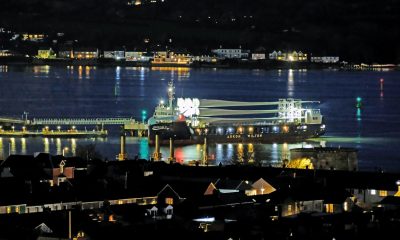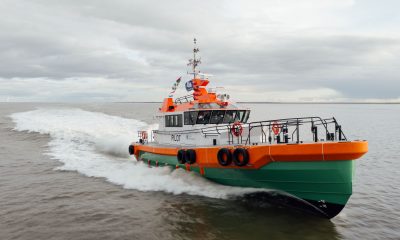News
Pembroke regeneration plans are well underway

 PLANS to regenerate Pembroke were further discussed in the latest meeting of Pembroke Town Council’s Regeneration Committee on Monday (Oct 17).
PLANS to regenerate Pembroke were further discussed in the latest meeting of Pembroke Town Council’s Regeneration Committee on Monday (Oct 17).
In light of a series of ‘masterplans across the county’, including Haverfordwest’s multi-million pound riverside and town centre development, Pembroke would appear to be next in line to undergo the regeneration process.
The plans for the project are still very much in preliminary stages. A draft plan has been formulated; however, no specific improvements to the town have been firmly established.
Throughout the meeting, councillors emphasised the need for a consultation process which will engage the ‘whole of the town’ and embrace public discussion, with Cllr Jonathan Nutting adding that decisions could not be made ‘without talking to everyone’.
The draft plans state: “Pembroke Town Centre requires a holistic vision looking at its retail and commercial function, its transport and parking systems, its cultural importance, landscape setting and historic built heritage, its public realm and its role as a workplace.”
Making reference to a previous presentation regarding the proposed masterplan for Pembroke, Mayor of Pembroke, Cllr Dennis Evans, said: “It did inspire a lot of us to think that maybe this is the time for Pembroke.”
Echoing Mayor Evans’ comment, Cllr Pauline Waters added: “It’s our turn out of the major towns in Pembrokeshire.”
While many councillors raised concern over the draft, given that it fails to address Pembroke specifically, and in turn, drew many similarities with the plans used for the regeneration of Haverfordwest, Mayor Dennis Evans emphasised: “This is a plan. This is an opportunity for us to move forward.”
Although the draft is not modelled to Pembroke specifically, there is still a clear set of ‘deliverables’ laid out within it. These include the identification of major development opportunities; early stage projects for immediate delivery and a spatial framework which included measures to focus on retail and town centre activity.
Many councillors used Haverfordwest’s efforts in developing its town centre as a positive point of reference, with some calling for Pembroke to adopt the ‘cultural centre’ approach and using terms such as ‘ideal’ to describe the development of the riverside market. Museums and galleries featured prominently in the discussion, as well as more general ‘cultural areas’.
While Cllr Blackburn acknowledged that Haverfordwest is ‘way down the line’ in its regeneration phase, Cllr Waters emphasised that ‘Haverfordwest didn’t happen overnight’.
With reference to St Michaels Church and St Michaels School, Cllr Waters added: “We have to make the best of what we’ve got, we’ve got some great buildings.”
Other members of the meeting emphasised the need to preserve the town’s heritage and raised the prospect of restoring historic sites, such as the old workhouse.
Cllr Nutting added: “We must protect what we’ve got. We have to say in our plan; these things are important and must be protected.”
Cllr Nutting also stressed that the plan should be presented to Pembrokeshire County Council ‘without emphasis on individual buildings’, and instead present a wide range of thoughts and proposals for Pembroke.
Mayor Dennis Evans subsequently suggested that members of the committee should each comprise a list of key buildings around the town and propose what should be done with them.
While the regeneration of Haverfordwest and the efforts of Pembrokeshire County Council in pushing forward with the plan for Pembroke were praised by many – Cllr Wyn Jenkins emphasised the importance of having ‘the authority in Haverfordwest on our side’ – this viewpoint was not shared unanimously.
Cllr Nutting said: “Pembrokeshire County Council has one thing in mind and that is Haverfordwest… a parochial, provincial market town.”
He added: “Pembroke Dock should not be languishing where it is – the money should have gone there.”
Backtracking on his previous remark, Cllr Nutting stated: “Don’t get me wrong, I love Haverfordwest.
“The more we shout, the more we make ourselves prominent and get what we want.”
Also present at the meeting was local architect Alan Collie, who issued words of warning to those present in the meeting.
Mr Collie warned: “Don’t get tied up with these posh consultancy plans. A lot of it is telling you what you already know but in a much longer form.”
Mr Collie also made reference to the amount of derelict buildings in the town, calling it ‘a disgrace’, something many councillors agreed with.
During the meeting, Cllr Jenkins called for original plans of a Pembroke regeneration, formulated some 30 years ago, to be revisited.
This development, named the Pembroke Maritime Village, would have seen a luxury hotel built on the waterfront of Castle Quarry. By dredging the Pembroke River and constructing lock gates and inlets into the quarry, boats travelling from all over the world would have been able to moor up having come through the main haven in Pennar.
The project would have also included the construction of chalets along the waterfront, as well as minor industry to support the river.
After four years of planning, Pembrokeshire County Council rejected the plans due to a local resident who raised concerns over ‘big industrial works’ being developed. Cllr Jenkins said no such industry was ever planned.
Cllr Jenkins said: “It would have made Pembroke and put it back on the map.”
Reflecting on the failed development, Cllr Jenkins described the situation as a ‘Pembroke problem’, adding ‘we can’t seem to get off the ground’.
Many councillors showed their support for the original plans to be ‘resurrected’, with Cllr Waters adding: “We need to capitalise on the waterways around our town.”
Throughout the meeting, the issue of timescales were also raised. Despite Mayor Dennis Evans having pointed out ‘this is not a quick process’, he, along with other members of the council, emphasised the looming nature of deadlines.
Former Pembroke Town Councillor Jan Gigler also raised the point that minutes for the regeneration meetings were not freely available to the public, something that the committee proved eager to address.
A public meeting was scheduled for 7pm on November 8 at Pembroke Town Hall. All local residents are encouraged to attend.
News
Conservatives reject calls for more Senedd powers amid Labour devolution row

WELSH CONSERVATIVE leader Darren Millar MS has dismissed renewed Labour calls for further Senedd powers, warning that the Welsh Government should “stop making excuses” and focus instead on tackling crises in health, education and the economy.
His comments follow an extraordinary intervention earlier this week by 11 Labour backbench MSs, who wrote to Prime Minister Sir Keir Starmer on 3 December accusing his government of “rolling back” devolution. The signatories — including former ministers Mick Antoniw, Lesley Griffiths and Lee Waters — said they were “increasingly concerned” by the lack of progress on key commitments such as reforming the Barnett formula, devolving rail infrastructure, policing and justice, and transferring the Crown Estate to Wales.
The letter singled out the UK Government’s new “Pride in Place” funding scheme — which sends regeneration money for town-centre improvements directly to Welsh councils — as a “constitutional outrage,” arguing that it sidesteps devolved powers through the UK Internal Market Act 2020. Although First Minister Eluned Morgan has raised the issue with Starmer, no Welsh ministers added their names to the letter, laying bare internal tensions as Labour falls back in polls ahead of the 2026 Senedd election.
Opposition parties seized on the dispute. Plaid Cymru’s Mabon ap Gwynfor MS said it showed Labour “falling apart,” while Welsh Liberal Democrat leader Jane Dodds criticised Westminster’s “deep lack of understanding” of the devolution settlement.
At a Council of the Nations and Regions summit on Thursday, Chief Secretary to the Treasury Darren Jones — standing in for Starmer — defended the UK Government’s record, saying Labour in Westminster had been “delivering at pace” in partnership with Wales. The 26 November Budget provided £508 million in additional resource and capital funding for Wales over the Spending Review period, alongside commitments to Port Talbot brownfield remediation, a South Wales semiconductor cluster, nuclear investment at Wylfa and a £547 million Local Growth Fund devolved to the Welsh Government. Welsh ministers welcomed many of these as having “generational” value, though the Labour MSs’ letter said they fell short of promised constitutional reform.
The Welsh Conservatives have consistently opposed further Senedd powers, arguing that Cardiff Bay already holds significant authority under the existing settlement established in 1997 and expanded in 2011, 2014 and 2017. Millar, who became Welsh Conservative leader in 2024, has previously ruled out abolishing the Senedd as unrealistic, while urging ministers to “transform people’s lives with devolution” by using existing powers more effectively.
Pointing to record pressures in devolved services, Millar said Labour was fixated on constitutional arguments while outcomes worsen. NHS waiting lists in Wales stood at 789,929 pathways by mid-2025 — nearly one in four residents — with first outpatient waits in parts of Rhondda Cynon Taf stretching from 28 to 68 weeks or more. Public satisfaction with the Welsh NHS averaged 5.1 out of 10 in the year to March 2025, down from 6.3 in 2021–22. Education attendance figures for 2023–24 showed slow post-pandemic recovery, while youth employment (16–24) fell to 52.5% in the year to March 2025. Wales’ unemployment rate rose to 4.1% in the year to June 2025, slightly above the UK’s 4.0%, with areas such as Swansea reaching 8.2%. Economic inactivity among 16–64-year-olds remained high at 24.1%.
Darren Millar MS said: “One Labour Government damaging Wales was bad enough — now we have two, and things are twice as bad.
After two damaging budgets, Welsh Government ministers are focused on infighting about Senedd powers instead of fixing the everyday problems families are facing.
The Senedd doesn’t need more powers. What we need is a government that accepts responsibility, stops making excuses, and uses the extensive powers already available to get to grips with the crisis in our NHS, improve standards in our schools, and tackle Wales’ spiralling unemployment.
Only a Welsh Conservative Government will fix Wales.”
The dispute reflects wider public debate on whether devolution is delivering results. Polling suggests consistent support for having a Senedd, but growing frustration over service performance. With the 2026 election approaching and Reform UK and Plaid Cymru gaining ground, Labour’s internal split over devolution exposes fresh vulnerabilities as the party tries to navigate its relationship with Westminster.
Entertainment
Capturing the stories of the stars at the Torch Theatre

RENOWNED storytellers Daniel Morden and Hugh Lupton are bringing a new intimate theatre experience to Wales next spring, exploring classic myths inspired by the night sky. Stars and their Consolations, produced by Adverse Camber Productions, will tour Wales in Spring 2026 and arrives at the Torch Theatre in March.
The production reimagines well-known Greek star myths through a blend of live storytelling, projected animations of the night sky and a mesmerising electro-acoustic soundscape created by award-winning Welsh composer Sarah Lianne Lewis.
The show has evolved from an earlier collaboration between Adverse Camber, Morden, Lupton and Lewis. Its first incarnation premiered in west Wales at the Beyond the Border Storytelling Festival 2021, and the company further developed the piece in 2022. This enhanced touring version promises a majestic, hypnotic experience that brings ancient tales to life with fresh theatrical energy.
Described as a beautiful way to reconnect with stories that have been shared around fires for thousands of years, the production explores familiar constellations such as Orion, Pegasus, the Pleiades, Sirius and the Milky Way.
Storyteller and co-creator Daniel Morden said: “Stars and their Consolations is a way of restoring the night sky. When we listen to these myths, we are connecting with our ancestors. It is as if a hand has reached out from the past and taken our own, and we feel less alone.”
The two-hour show, suitable for ages 12 and over, invites audiences into an enthralling world where gods toy mercilessly with mortals, and stories of pride, lust and passion unfold against the vast canvas of the cosmos. The epic sweep of the sky, the creators say, offers a grounding and consoling perspective on human troubles.
Producer Naomi Wilds added: “Stories shared together bring people together. We all live under the same sky, though it looks different depending on where you stand. Star-related stories help us remember constellation patterns, mark the seasons and even warn us about issues such as light pollution. They remind us why the night sky is valuable, and why we must protect it for future generations.”
Six-month bilingual storytelling project across Wales
Ahead of the spring tour, Adverse Camber—supported by Prosiect Nos Partnership, Theatrau Sir Gâr, Arts Council Wales, The National Lottery Heritage Fund, Colwinston Foundation, The Darkley Trust, Welsh Government, Literature Wales and People Speak Up—is launching a six-month initiative: Cysur y Sêr (The Comfort of the Stars).
This Welsh-led, bilingual project will develop new Welsh-language stories, explore the environmental impacts of light pollution and climate change, and leave a long-lasting storytelling legacy. Ten bilingual storytellers will work with communities near venues across Wales in the lead-up to Dark Skies Week in February 2026, before linking into the touring production in March and April.
Although Stars and their Consolations focuses on Greek mythology, the creative team emphasises that Wales itself has some of the best protected night skies in the world—and a largely forgotten tradition of celestial storytelling.
Morden noted: “The Welsh landscape used to be populated with stories. We’ve forgotten many of them—on the ground and in the heavens. If STARS helps make the night sky magical and precious again, perhaps we will do more to protect it.”
Dani Robertson, Dark Sky Officer for the Prosiect Nos Partnership, added:
“Interest in Dark Sky watching across Wales is growing. We suspect many of the star stories once told in rural and coastal communities have been lost, but Cysur y Sêr may uncover memories people still hold. Sharing them helps pass this knowledge on to the future.”
How to watch
Stars and their Consolations will appear at the Torch Theatre on Tuesday, 24 March.
For more information and tickets, visit www.torchtheatre.co.uk
or contact the Box Office on (01646) 695267.
Community
St Davids lights up for annual Christmas tree and wreath contest

Menevia WI, Girl Guides and local groups among the winners at a packed Cross Square event
CHARITIES, schools and community groups lit up St Davids on 29 November 2025, showcasing creativity, craftsmanship and festive spirit as hundreds gathered in Cross Square for the annual Christmas Tree and Wreath Competition.
The winners were chosen by public vote. Taking first place in the adults’ category was Menevia WI, whose extraordinary tree, nativity scene and decorations were ingeniously created from a clothes airer and wooden pegs.

Second place went to the City Council Coffee and Chat Group with a thoughtful Christmas-and-Remembrance design, featuring hand-knitted red, white and blue decorations. St Davids RNLI secured third with a lifeboat-themed tree celebrating their lifesaving work.
In the children’s category, St Davids Girl Guides took the top spot with a charming design featuring “Girl-Guide-ified” Santas, tents and the iconic Guide logo. Ysgol Penrhyn Dewi (YPD) came second with a colourful puzzle-themed tree carrying the message: “In this school you are a special piece of the puzzle.” Close behind in third place was Brawdy Hayscastle YFC with an inventive cow-themed Christmas tree.
The wreath category also highlighted the community’s talent. The Drifters claimed first place with a striking star-shaped wreath, while Lego Church secured second with a brilliantly crafted Lego design. Third place went to Rebecca Thornton for her beautifully knitted wreath featuring Santa and his reindeer.
As the Christmas lights were switched on and Cross Square filled with families, the event once again showcased the creativity and community spirit that make Wales’s smallest city shine at Christmas.
-

 Crime3 days ago
Crime3 days agoDefendant denies using Sudocrem-covered finger to assault two-month-old baby
-

 News2 days ago
News2 days agoBaby C trial: Mother breaks down in tears in the witness box
-

 Crime2 days ago
Crime2 days agoPembroke rape investigation dropped – one suspect now facing deportation
-

 Crime7 days ago
Crime7 days agoMan denies causing baby’s injuries as police interviews read to jury
-

 Crime3 days ago
Crime3 days agoLifeboat crew member forced to stand down after being assaulted at Milford pub
-

 Crime3 days ago
Crime3 days agoDefendant denies causing injuries to two-month-old baby
-

 Crime3 days ago
Crime3 days agoPembrokeshire haven master admits endangering life after speedboat collision
-

 Crime1 day ago
Crime1 day agoMother admits “terrible idea” to let new partner change her baby’s nappies alone



















